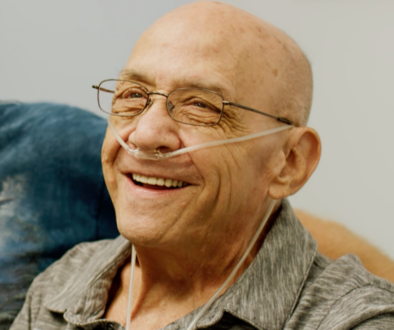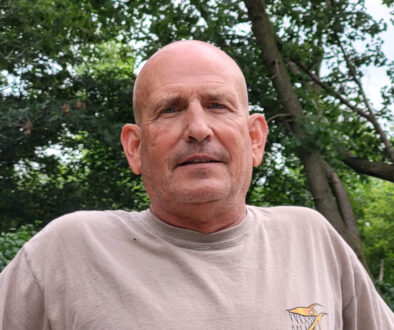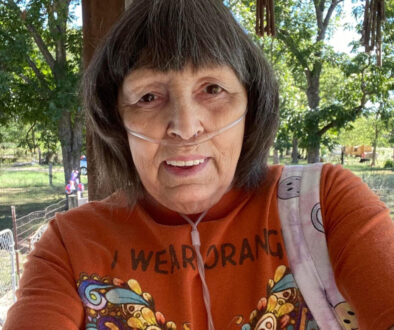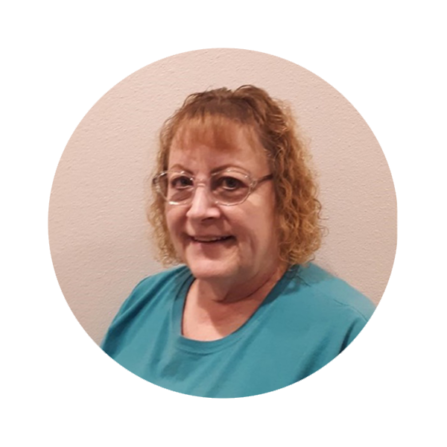
Regina’s Story
“As soon as I went home, the difference was amazing. Not only could I breathe better but I could walk up and down the stairs and do my own grocery shopping.”
Procedure Details:
Age at Treatment: 64
Hospital: UT Health East Texas Pulmonary Institute
Date of Procedure: July 2022
Regina’s Story
“As soon as I went home, the difference was amazing. Not only could I breathe better but I could walk up and down the stairs and do my own grocery shopping.”
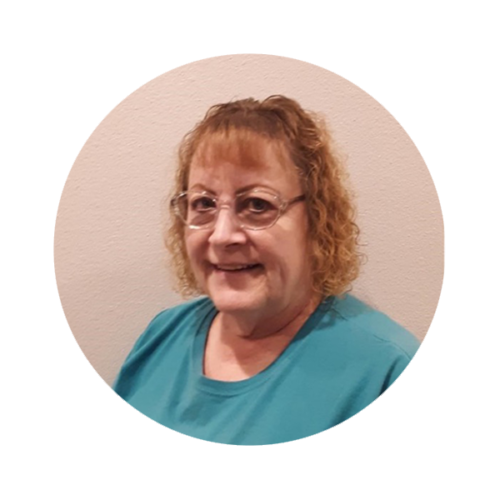
Procedure Details:
Age at Treatment: 64
Date of Procedure: July 2022
Hospital: UT Health East Texas Pulmonary Institute
Hometown: Pritchett, Texas
Life Before Zephyr® Valves:
I was diagnosed with mild to moderate COPD in my early 40s and used inhalers as needed. Before COPD, I was always working and led a very busy life. I was a Police Officer for many years, and later in life, I was a greeter at Walmart. I lived alone and took care of my house and yard all by myself. I also enjoyed outdoors — both hiking and biking.
It wasn’t until I was 60 in 2018 when I joined an exercise club that my condition went downhill. Even though I was trying to take care of my health and stay fit, I just felt worse and worse. My primary doctor referred me to a pulmonologist who put me on oxygen. That was devastating and had a big impact on my life. The mobile oxygen canisters didn’t work for me. It would make my nose run, so it was hard to go anywhere. I felt very depressed and would cry for no reason. I had looked forward to retirement for so long. I had big plans but because of this disease I could not do many of the things I planned. I just felt like a prisoner in my own house.
I felt I was at the point that I didn’t have much time left. My pulse was over 120 every day just to try to keep up with my breathing. During this time, I was helping out a disabled neighbor. He said to me, “Get those valves put in like they do with the heart.” I had never heard of valves for the lungs, but his comment prompted me to research, and I discovered the Zephyr Valves. My pulmonologist didn’t know of them but helped me find Dr. Gass who did the procedure. During the screening they found blood clots in both my lungs, so they treated those first and I finally got Zephyr Valves in July 2022.
My niece’s house is on a hill and there are steps up to the door. I was able to go up every one of them. I wasn’t winded, and I could talk and breathe at the same time again.
– Regina
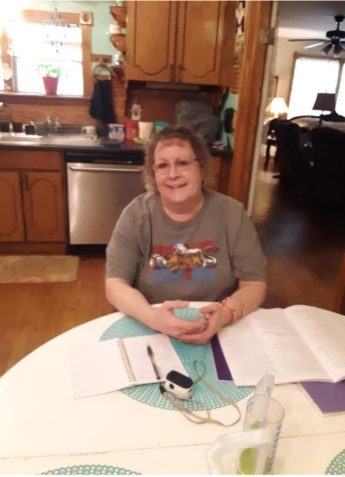
Life After Zephyr Valves:
The procedure went smoothly for me. I stayed in the hospital for three nights as required but had no complications. At first my neck and shoulders felt a bit sore, likely because of the position I was in for the procedure. But as soon as I went home, the difference in my breathing was amazing. Not only could I breathe better but I could walk up and down the stairs and do my own grocery shopping.
My niece’s house is on a hill and there are steps up to the door — I was able to go up every one of them. I wasn’t winded, and I could talk and breathe at the same time.
I still use O2, and my legs sometimes feel weak. But my PFTs look good. I still take it slow, but I can do it, and that is a very big deal to this independent woman.
I have a trip planned to travel to Ohio to see my cousin. Last time she came to me, so it’s my turn and I am thrilled to be able to make that trip.
Results may vary.
Caution: Federal law restricts this device to sale by or on the order of a physician.
¹Criner, G et al. Am J Resp Crit Care Med. 2018; 198(9):1151‒1164.
US-EN-1729-v1
What is the Zephyr Valve procedure?
The Zephyr Valve has been shown to help patients breathe easier, do more, and enjoy life.1
Despite taking the best available medications, many patients with severe COPD/emphysema suffer from hyperinflation of their lungs where air becomes trapped in the lungs, preventing fresh air from entering and thereby causing severe shortness of breath.
The Zephyr Valves reduce lung hyperinflation by allowing trapped air to escape and preventing new air from entering that diseased lobe. This allows the healthier parts of the lung to function better and results in patients being able to breathe more easily and experience less shortness of breath.
The valves are placed via bronchoscopy, with no incision or cutting, so these benefits are achieved without the risks of traditional surgical options. The procedure is usually complete in under an hour.
Complications of the Zephyr Endobronchial Valve treatment can include but are not limited to pneumothorax, worsening of COPD symptoms, hemoptysis, pneumonia, dyspnea and, in rare cases, death.
-
I was diagnosed with mild to moderate COPD in my early 40s and used inhalers as needed. Before COPD, I was always working and led a very busy life. I was a Police Officer for many years, and later in life, I was a greeter at Walmart. I lived alone and took care of my house and yard all by myself. I also enjoyed outdoors — both hiking and biking.
It wasn’t until I was 60 in 2018 when I joined an exercise club that my condition went downhill. Even though I was trying to take care of my health and stay fit, I just felt worse and worse. My primary doctor referred me to a pulmonologist who put me on oxygen. That was devastating and had a big impact on my life. The mobile oxygen canisters didn’t work for me. It would make my nose run, so it was hard to go anywhere. I felt very depressed and would cry for no reason. I had looked forward to retirement for so long. I had big plans but because of this disease I could not do many of the things I planned. I just felt like a prisoner in my own house.
I felt I was at the point that I didn’t have much time left. My pulse was over 120 every day just to try to keep up with my breathing. During this time, I was helping out a disabled neighbor. He said to me, “Get those valves put in like they do with the heart.” I had never heard of valves for the lungs, but his comment prompted me to research, and I discovered the Zephyr Valves. My pulmonologist didn’t know of them but helped me find Dr. Gass who did the procedure. During the screening they found blood clots in both my lungs, so they treated those first and I finally got Zephyr Valves in July 2022.
-
The procedure went smoothly for me. I stayed in the hospital for three nights as required but had no complications. At first my neck and shoulders felt a bit sore, likely because of the position I was in for the procedure. But as soon as I went home, the difference in my breathing was amazing. Not only could I breathe better but I could walk up and down the stairs and do my own grocery shopping.
My niece’s house is on a hill and there are steps up to the door — I was able to go up every one of them. I wasn’t winded, and I could talk and breathe at the same time.
I still use O2, and my legs sometimes feel weak. But my PFTs look good. I still take it slow, but I can do it, and that is a very big deal to this independent woman.
I have a trip planned to travel to Ohio to see my cousin. Last time she came to me, so it’s my turn and I am thrilled to be able to make that trip.
-
The Zephyr Valve has been shown to help patients breathe easier, do more, and enjoy life.1
Despite taking the best available medications, many patients with emphysema, a common form of COPD, suffer from hyperinflation of their lungs where air becomes trapped in the lungs, preventing fresh air from entering and thereby causing severe shortness of breath.
The Zephyr Valves reduce lung hyperinflation by allowing trapped air to escape and preventing new air from entering that diseased lobe. This allows the healthier parts of the lung to function better and results in patients being able to breathe more easily and experience less shortness of breath.
The valves are placed via bronchoscopy, with no incision or cutting, so these benefits are achieved without the risks of traditional surgical options. The procedure is usually complete in under an hour.
Results may vary.
Caution: Federal law restricts this device to sale by or on the order of a physician.
¹Criner, G et al. Am J Resp Crit Care Med. 2018; 198(9):1151‒1164.
Results from case studies are not necessarily predictive of results in other cases. Results in other cases may vary.

